The Apple Mac Mini M1 edition has made its impact on STH. We now have three M1 Mac Mini 1GbE models. Two have 8GB of RAM but one has 16GB. During the latest Apple event, there was a small 10GbE update to the Mac Mini that was not mentioned. We immediately ordered one, and after it arrived we have a simple conclusion: it is really good. In this mini-review, we are going to discuss why we recommend this $100 10Gbase-T upgrade for those venturing into the realm of the M1 Apple Mac Mini.
Video Version
We have a fun video for this one that you can see here:
As always, we advise opening this in a new YouTube window/ tab/ app for a better viewing experience. For those who have been watching our TinyMiniMicro series, there is a fun section in this one at the “Hiatus” chapter marker.
Apple Mac Mini M1 10GbE Edition Hardware Overview
Let us get to the hardware behind the Mac Mini M1 10GbE edition. First, we get the same chassis that we saw in the standard M1 that was launched in 2020. There is no surprise there.
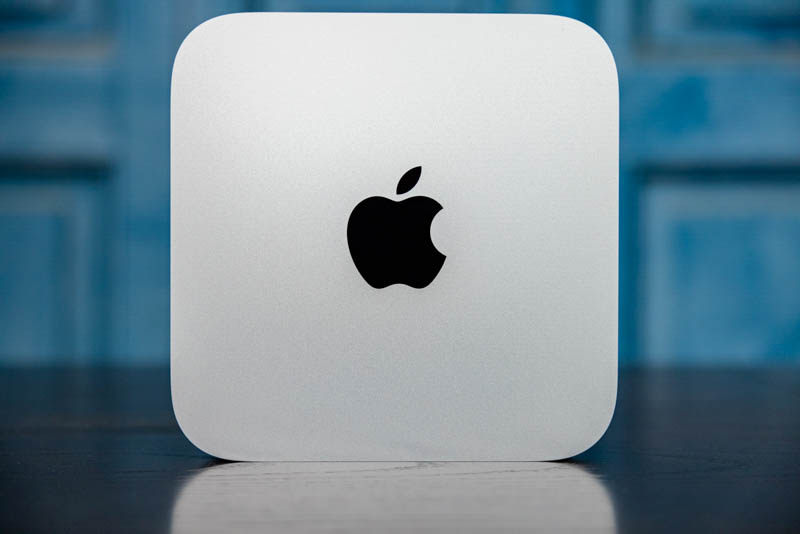
The clean Apple aesthetic makes three of the sides barren except for a power indicator. A fourth side has the Apple logo. There is very little going on here.
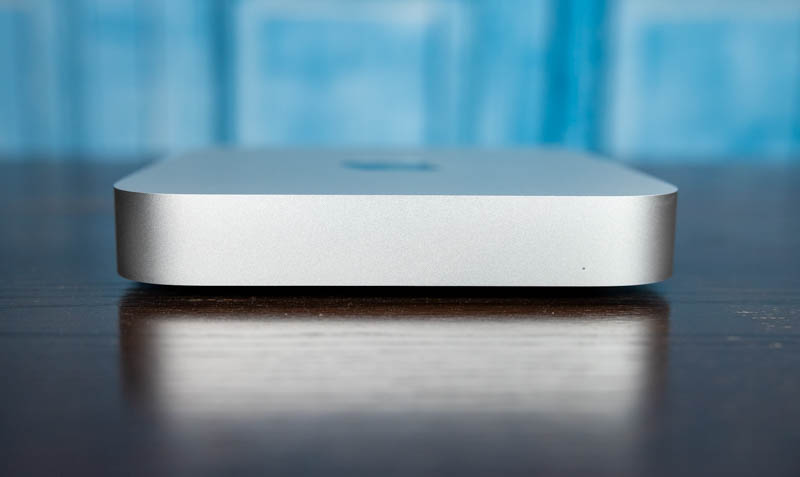
The bottom of the unit has the Mac mini model and also has a vent for cooling. The fact that this is not a metal protrusion means that one does not have to worry about scratching a table as one would if it was metal. This is all going to look familiar compared to previous Mini’s.
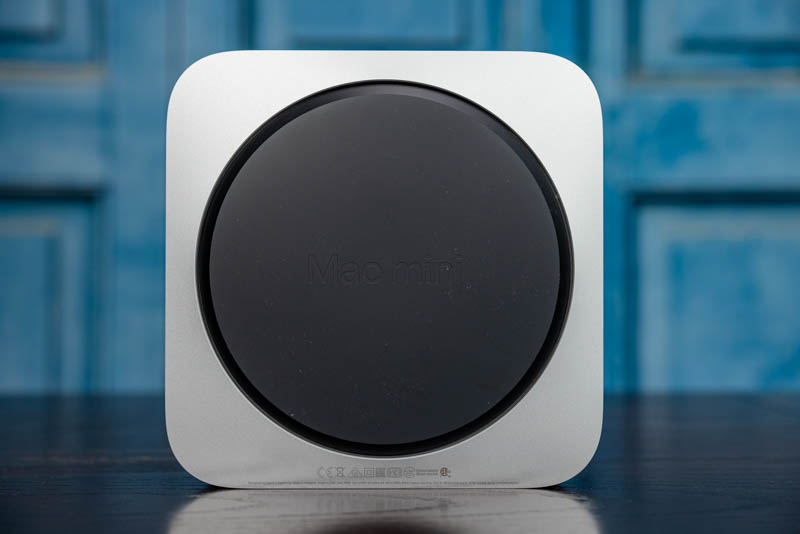
On the rear, we get another vent but then the primary I/O of the system. In the middle of this I/O and above that vent we get two USB 4 (40Gbps)/ Thunderbolt 3 ports and a HDMI 2.0 port. One can get a different display output via a Thunderbolt port.
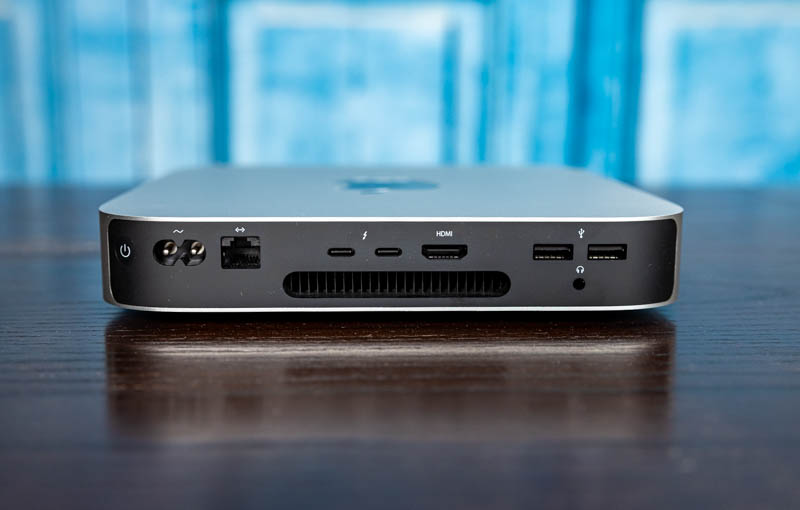
On the right rear, we get two USB 3.1 Gen2 ports which are 10Gbps Type-A ports and a headset jack below them.
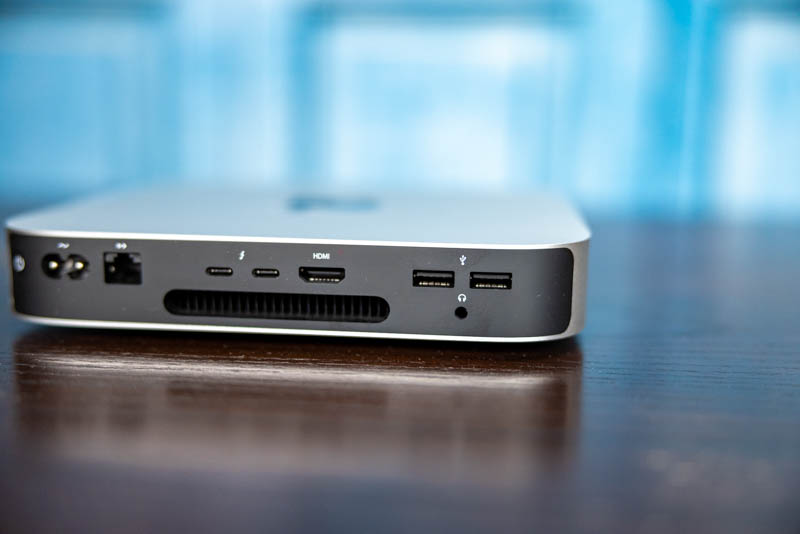
On the left rear we get the power button and power input. Unlike Project TinyMiniMicro nodes, this has an internal power supply. While the Mac Mini M1 is larger than the ~1L corporate desktop PC segment as we showed in our Lenovo ThinkCentre M920x Tiny Review and Guide, the internal power supply makes up much of the balance.
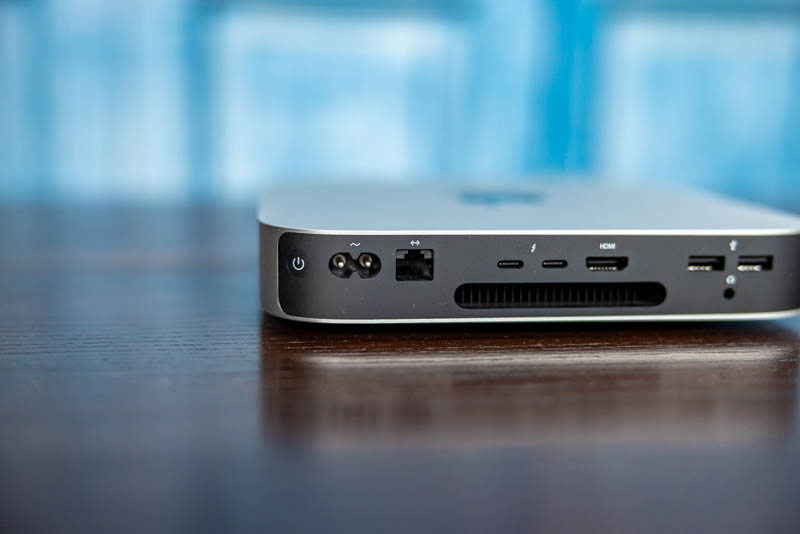
The big feature though is the RJ45 NIC. In this case, we get a 10Gbase-T NIC which is a new option on the M1 Mac Mini’s for 2021.
Next, we are going to look at that 10GbE NIC and the impact it has on configurations.

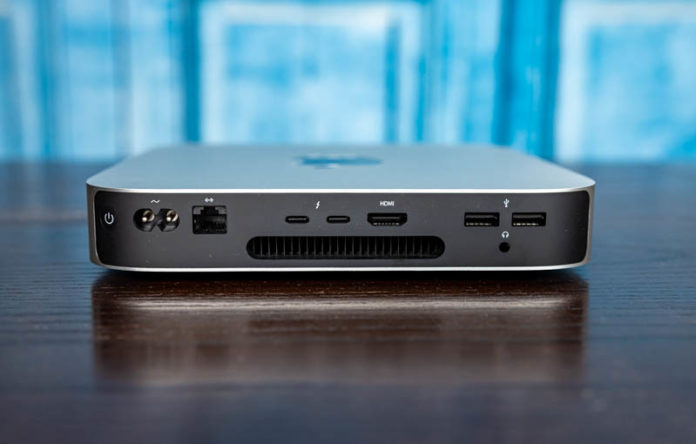



Thanks for the review! We looked into rack mounting some (x86 64GB 10Gbps) Mac Minis in the DC for users during lockdown. Previous versions could run VMWare, but the T2 chip broke compatibility.
I’d prefer everyone move to flexible NBaseT rather than 2.5Gbps.
There’s space in a market for a small (several liter) x86 with internal power supply, NBaseT, & IPMI. XeonD ITX would be ideal, but frustrating scarce. The upcoming Ice-Lake XeonD would be a homelab dream.
Wonderful review Patrick! Quick confirmation: the previous M1 MacMini (and all of the other M1 devices) have only been able to run one external monitor (even if you try to use a USB or thunderbolt to display adapter). Has that limitation been removed on the M1 MacMini with the 10Gbase-T NIC?
The AQC113 has PCIe 4.0 x4 interface.
https://youtu.be/1-wWaW2cLNY?list=PLk3ZMQnA0uUpuqGGc46pdaAMXValW2qMT&t=55
<>
There is no AQC113 there:
https://www.marvell.com/products/ethernet-adapters-and-controllers/fastlinq-edge-ethernet-controllers.html
So should we guess it’s a special version for/from Apple?
<>
As you said, PCIe Gen 3 1x at 8.0 GT/s is not going to approach 10GbE. So it’s Gen 4?
Does anything useful show up in the I/O Registry Explorer or using the ioreg command?
Note: I know nothing about this two, I just looked for lspci equivalent on Mac OS.
What speed do you get with one client stream?
Which machine was server, which machine was client? Did you try both directions?
[…As we can see, we have an “Apple AQC113” which is a Marvell-Aquantia AQction, based NIC…]
There is no AQC113 there:
https://www.marvell.com/products/ethernet-adapters-and-controllers/fastlinq-edge-ethernet-controllers.html
So should we guess it’s a special version for/from Apple?
[…We fired up iperf3 with -P 4 to push enough traffic, and we got between 9.4-9.5Gbps…]
PCIe Gen 3 1x at 8.0 GT/s is not going to approach 10GbE. So it’s Gen 4?
Does anything useful show up in the I/O Registry Explorer or using the ioreg command?
Note: I know nothing about this two, I just looked for lspci equivalent on Mac OS.
What speed to you get with one client stream?
Which machine was server, which machine was client? Did you try both directions?
The marvell website lists the following chip:
AQC113/AQC113C/AQC113CS: Single-port 6speed, 10Gbps PCIe to Multi-Gig Ethernet controller integrates MAC and PHY with I-grade support.
Did they update the listing or am I mistaken.
And while I agree that 2.5 Gbe on the base model would be nice, the recent TrendNet reviews showed that the pricing is not there yet for the casual use and that it’s probably better to offer full 10G nbase-T as an upgrade to those willing to pay.
2.5 and 5 gb ethernet are nothing more than a means to extend the price bump for faster networking a few more years. Seriously, stop supporting it. The same logic that gave us 10 then 100 then 1000 baseT still applies. Go to 10 gbaseT or go home.
@Patrick Kennedy, love the “old models meets new model” kitchen fun ! We need some fun in these serious times :-)
Nice review!
How is it with audio when you access network through WLAN and 10 Gbps interface.
Under Windows I am sometimes getting audio drops on my Supermicro X10SRi-F mainboard.
It became better when replacing the Microsoft network driver in Win10 with the latest one from Intel v26.2.
The question behind it is .. I have the feeling my system was more stable in regards to audio under Windows 7 compared to Windows 10. Especially before all the changes because of Spectre and Meltdown. I am questioning myself, whether I could have an advantage for audio processing (DAW work) when using Apple. I know that ASIO drivers are working a little bit more efficient compared to Apple where everything has to go through their audio stack, so they usually need some more safety buffers because audio requires a few more system calls.
But when I notice on the other hand, that audio is not so stable anymore under Windows 10, then I am questioning myself, whether Apple could solve such issues ….
Does anybody know what I mean and has a wise answer ?
@Paul: oops, you’re right. I missed it. Forgot to scroll the page.
Found answers to my questions there: https://www.youtube.com/watch?v=Akqx0F5-gs4
$1,400 for Mac Mini M1, 16GB memory, 1TB storage, 10 GbE, I’m almost tempted for iOS development workstation to replace aging iMac. I don’t care about graphics for games. I would wish 12 or 16 cores and 32GB of memory for < $2,000. Fat hard disk via Thundebird OK.
Thanks for the review. Good to see the 10Gb option from Apple. The 2.5Mb (& 5Mb) are good forward thinking Base Options, I think, since Laptop owners & some older desktops with limited PCIe slots might only have the USB 3 port option with 2.5 & 5Mb NIC Adapters (see STH reviews). That is a really fast upgrade along with 2.5Gb Switches (see STH reviews).
So if you r hardware limited (PC, Laptop, etc) then 10Gb isn’t always an easy option.
Sir Patrick, Keep up the good work.
AQC113cs based card works as pcie4.0…
LnkCap: Port #0, Speed 16GT/s, Width x2, ASPM L0s L1, Exit Latency L0s <4us, L1 <64us
….so even in an x1 slot it should be as fast as the test in this article correct?
Unfortunately the macOS AQC113 firnware/driver has a huge issue with VLANs that are also configured with large MTU (9000 bytes). Although this is a fully supoported oconfiguration, and works perfectly with the AQC107 hardware/firmware/driver, with the AQC113 hardware/firmware.driver this combination (VALN with jumbo frames) results in terrible performance and continual connection drops for user space processes and total system lock ups for kernel space traffic (such as SMB). Issue reported to Apple months ago foe Ventura and now again for Sonoma Beta 6 (same firmware and driver, same issue) but no acknowledgement or action…